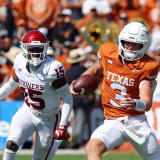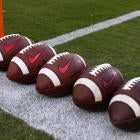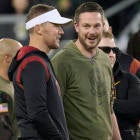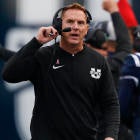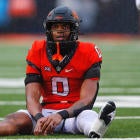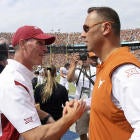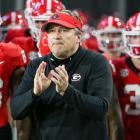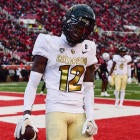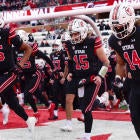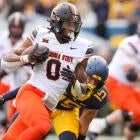Name, image and likeness rights are no longer a debate. In some form, legislation is coming. Players will be able to be compensated for their God-given talents on and off the field. It's just a question of how, when and to whom the money will be flowing.
That much is certain as the NIL issue takes its next step. The Board of Governors Federal and State Legislation Working Group is expected to submit recommendations to the NCAA Council during its next meeting Thursday and Friday in Indianapolis, Indiana.
The NCAA does not allow its athletes to capitalize financially on what is a birthright for the rest of us: the ownership of one's name, image and likeness.
But as athletes woke up and legal pressures mounted, the NCAA quickly went from fighting the concept to embracing it and even asking Congress for help implement it.
Coming out of this meeting, the NCAA will look a lot different than the group that once considered cream cheese on a bagel to be an extra benefit. In short, the NCAA will lose a bit of its big-brother swagger.
Athletes will have more visibility and power -- as well as money. The association won't have any choice but to allow tennis players to become Instagram stars, point guards to start their own YouTube channels and swimmers to get six-figure bonuses for winning gold medals.
It's all about the NCAA living up to its mantra that athletes in college should experience life as normal students as much as possible.
"Since regular students have the opportunity to exploit their name, image and likeness, we've always felt students who are athletes should have a version of that," said Notre Dame athletic director Jack Swarbrick.
Don't necessarily expect an announcement from the NCAA on Friday. The Board of Governors still has to approve any changes. But this is the next significant step in the process. Out of this will likely come proposed legislation. It will be processed in January at the NCAA Convention and could be formalized in 2021.
We've gotten this far, though, which is significant considering the progress made since last Sept. 11. The NCAA Board of Governors sent a letter to California Gov. Gavin Newsom basically threatening that all 58 NCAA schools in the state could be thrown out of the association. Seven weeks later, the NCAA said it would "immediately consider modernization" of NIL rules.
In that sense, college athletics became woke.
These observations come after several months of speaking with sources about how NIL could function while the NCAA retains its amateurism legitimacy.
It's really not that hard.
There will be agents ... lots of agents
One of the working group recommendations is expected to be player representation. Yes, agents for everyone while players are still in school. It's only fair. In the new NIL world, some of these athletes are going to be making six figures and more (see below). They need to know how negotiate deals. "That's something that five years ago we wouldn't have even considered," said that working group member. "Today, I think we have to consider it."
College baseball players are allowed to have "advisors." Since 2018, basketball players who declare for the draft have been allowed to hire agents. They can come back to play if they aren't drafted. The NIL version is a bit different. There are approximately 13,000 FBS players alone. Not all of them will require agents. But remember, this isn't necessarily an athletic issue. The agents will be negotiating endorsement deals, autograph signings, group licenses.
"There are going to be a slew of agents coming at them," said Courtney Altemus, who runs TeamAltemus, a financial advisory firm that works with the NCAA. "Whether it's agents, financial agents, marketing advisors, insurance sales people … it's going to increase exponentially. It's going to hit Division III athletes."
All of it is going to require intense scrutiny. Several states already have agent registration laws. But those laws only work if they have teeth and the attorneys general of those states prosecute wrongdoers. With all these potential new clients on the market, those potential wrongdoers could be everywhere.
Considering the black market in basketball (see "The Scheme" on HBO), certified player agents working in the open with athletes would be a welcome relief. "Sunshine is the best disinfectant," one working group member said.
Recruiting will change
This is the thorniest issue in the NIL space for the key stakeholders. They have to create enough what have been called "guardrails" -- boundaries that keep a fat cat booster from buying the whole recruiting class. (No jokes, please, about the current recruiting climate.)
"There's going to be a period of anarchy," that same working group member said.
Expect a clearinghouse of sorts for the new business partnerships. The local Ford dealer would have to disclose the endorsement contract it has with the star quarterback. That contract would then be vetted for fair market value. In other words, the five-star freshman who has yet to play a game can't get $500,000 for an autograph signing.
"The incentive is not, 'I think your autograph is valuable and I want to pay for it,'" Swarbrick said. "It's, 'I think your autograph on a national letter of intent [is so valuable] that I want to pay for it.'"
When a player signs a letter of intent, he/she would have to disclose any previous third-party partnership. That sort of cleans up any previous high school endorsement relationship. But enforcing violations would be an issue. The NCAA can't enforce many of its medical guidelines. How is it going to dig down on endorsement contracts?
Save us, Congress
The NCAA quickly went from fighting NIL to asking the Congress for help. Last September, NCAA president Mark Emmert called NIL legislation "an existential threat" to the collegiate model. In December, he said the association would need help from Congress implementing it.
That was significant. The NCAA has always stiff-armed the federal government. Now it needs Congress to make any NIL regulations stick. Furthermore, it has been backed into a legal corner with 30-plus states at least considering an NIL law. It can't fight 30 separate laws so it will capitulate.
Congress has taken the lead. Rep. Anthony Gonzalez (R-Ohio) might be the most plugged in because he played the game. Rep. Mark Walker (R-NC) has introduced an NIL bill. Senators Mitt Romney (R-UT), Chris Murphy (D-NY) and Marco Rubio (R-FL) are working on a bill.
In a sense, the issue has hit a sweet spot. NIL has bipartisan support of lawmakers who sense a win with voters who sympathize with the plight of the college athlete. The likelihood of Congressional intervention on NIL anytime soon was already in doubt with this being an election year. Throw in the coronavirus, and Congress' attention probably shouldn't be on NIL the rest of this year.
That makes July 1, 2021, a soft deadline for the NCAA. That's when Florida's law -- the first in the country -- goes into action. The NCAA must have something in place by then. The guess here is that the NCAA passes some sort of legislation next year that Congress can use as a template for federal legislation. But in an election year with the coronavirus, who knows when NIL gets Congress' attention?
Who will benefit, and how much will they earn?
In a perfect world, competitive balance won't be impacted. SEC football coaches sat in their spring meetings a couple of years ago literally debating a recruiting advantage if, say, Auburn athletes got $100 more per month in cost of attendance than Alabama. Nothing changed then. The balance of power won't shift with NIL. Alabama will continue get the best football recruits. Toledo won't.
Swarbrick is one college athletics' deepest thinkers. He believes the largest earners in the NIL won't necessarily be the most popular athletes. "I think it's whether what you're producing has value," Swarbrick said.
Think then about the instructional video by an athlete that takes off. Think about a social media influencer. During its deliberations, the working group heard from former Columbia wrestler Dylan Geick. While wrestling as a freshman, Geick became an Instagram star, endorsed products and wrote poetry.
"I was allowed to do this through a waiver process where I had to prove that my wrestling did not contribute to the growth of my personal brand," Geick told Outsports. "My role in front of this [NCAA] committee was to express how a modern college athlete might benefit financially off of their newfound celebrity. I wanted to help them better understand that the old idea of modeling contracts, TV commercials and usual advertisements that athletes might have engaged in 20 years ago would no longer be a concern."
It will definitely be a new world. Think of some form of the "NCAA Football" video game returning. Navigate Research estimated group licensing video game deals to be worth $1,000-$10,000 per player. Also per Navigate, assigning a value of 80 cents per Instagram follower, LSU quarterback Joe Burrow's endorsement value alone would have been $700,000 last year.
Clemson's Trevor Lawrence could earn $3,000 per Instagram post. If that's accurate, we could see college athletes approach millionaire status with a few keystrokes. Lawrence isn't even the projected highest earner in the college space. North Carolina guard Cole Anthony had an endorsement potential of $476,000.
The NFLPA has already offered college players help in group licensing agreements.
NIL is expected to create a new pool of high-earning Olympic sports athletes. There may be new opportunities for female athletes. Two-time gold medalist Lilly King told the Wall Street Journal she missed out on $100,000 in bonuses from the Olympics after deciding to return to Indiana. Former Stanford swimmer Katie Ledecky had to give up the sport in college in order to be able to earn her endorsement money. She just signed a $7 million deal with apparel maker TYR Sport.
What it all means
Will you -- the consumer -- be turned off if the starting quarterback is hawking Buicks? If the point guard is producing records, does it matter? Probably not. That's what the NCAA has missed out on for years. Not allowing NIL keeps athletes from their full college experience. It certainly won't professionalize them in the eyes of fans who root for whoever is wearing those Ohio State and Michigan jerseys.
Fan loyalty is built over decades, by tradition and a shared experience of attending that school. Fan loyalty is built by the thrill of game day, not by who has the most social media followers.
Some suggest NIL might not be the windfall it is made out to be. Because of copyrights, endorsements will probably not include any reference to a player's school. For all but the top tier of athletes, that devalues the compensation right there.
That's OK. This issue is more about the players earning their long-denied rights than earning a paycheck.
But with the coronavirus, there will be more sympathy in general for athletes now that their athletic and educational dreams have been upended. For thousands, their careers were ended prematurely. That's not a good optic for the NCAA, which has twice in the last five years been found in violation of the Sherman Anti-Trust Act.
Basically, its bylaws capping compensation for athletes was against the law. The new world of college athletics looks refreshing, exciting and, finally, fair.


